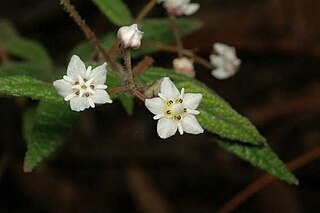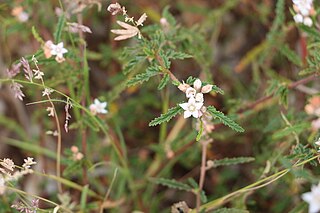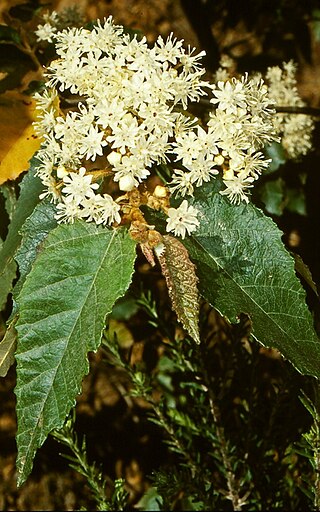
Commersonia dasyphylla, commonly known as kerrawang, is a species of flowering plant of the family Malvaceae and is endemic to eastern continental Australia. It is a shrub with egg-shaped to lance-shaped with irregular edges and flowers in groups of up to 21, followed by hairy brown capsules.

Androcalva fraseri, commonly known as blackfellow's hemp or brush kurrajong, is a species of flowering plant in the family Malvaceae and is endemic to eastern Australia. It is a small tree or shrub that forms suckers and has egg-shaped or lance-shaped leaves with serrated edges, and clusters of 13 to 21 white flowers.

Commersonia hermanniifolia, commonly known as wrinkled kerrawang, is a species of flowering plant in the family Malvaceae and is endemic to New South Wales. It is a prostrate or trailing shrub with oblong to lance-shaped leaves that are paler on the lower surface, and flowers with five white sepals fading to pink and five pinkish petals.
Commersonia parviflora, commonly known as small flowered rulingia, is a species of flowering plant in the family Malvaceae and is endemic to the south of Western Australia. It is a low, prostrate or dense shrub with wrinkled, egg-shaped leaves with rounded teeth on the edges, and clusters of small, white flowers.

Commersonia rugosa is a species of flowering plant in the family Malvaceae and endemic to New South Wales. It is an open, straggly shrub with linear to narrowly egg-shaped leaves with irregular teeth or lobes on the edges, and white flowers in clusters of 3 to 15.
Commersonia gilva, commonly known as golden commersonia, is a species of flowering plant in the family Malvaceae and is endemic to the south-west of Western Australia. It is an erect shrub with elliptic to oblong or egg-shaped leaves and yellow flowers.
Androcalva argentea is a species of flowering plant in the family Malvaceae and is endemic to Queensland. It is a tall shrub that forms suckers from rhizomes and has silvery branchlets and leaves, the leaves egg-shaped with wavy edges and serrated, and dense clusters of 10 to 30 white to cream-coloured flowers.
Androcalva beeronensis is a species of flowering plant in the family Malvaceae and is endemic to Queensland. It is a shrub that forms suckers from rhizomes and has branchlets and leaves covered with soft, golden hairs, the leaves egg-shaped to lance-shaped with toothed edges, and clusters of 9 to 24 cream-coloured to white flowers.

Androcalva crispa, commonly known as crisped leaf commersonia, is a species of flowering plant in the family Malvaceae and is endemic to the south-west of Western Australia. It is a prostrate shrub that forms suckers from rhizomes and has densely new growth, clusters of lobed, egg-shaped or oblong leaves with wavy, serrated edges, and groups of white and pinkish-purple flowers.
Androcalva inglewoodensis is a species of flowering plant in the family Malvaceae and is endemic to south-eastern Queensland. It is a spreading, prostrate shrub that has hairy young branchlets, egg-shaped to elliptic leaves with irregularly serrated edges, and small groups of white to cream-coloured flowers.

Androcalva johnsonii is a species of flowering plant in the family Malvaceae and is endemic to central Queensland. It is a low, spreading shrub that has hairy young branches, narrowly egg-shaped or oblong leaves with rounded teeth, and small groups of white to pale pink flowers.
Androcalva lachna is a species of flowering plant in the family Malvaceae and is endemic to the far west of Western Australia. It is an erect shrub with egg-shaped leaves, and heads of 4 to 12 white and pink flowers.
Androcalva leiperi, also known as Leiper's commersonia, is a species of flowering plant in the family Malvaceae and is endemic to a restricted part of south-east Queensland. It is an erect or prostrate shrub that has brown bark, lance-shaped leaves with 4 to 7 pairs of rounded serrations on the edges, and groups of 3 to 12 white flowers.
Androcalva microphylla is a species of flowering plant in the family Malvaceae and is endemic to the south-west of Western Australia. It is an open, straggling shrub with egg-shaped to oblong leaves with a heart-shaped base, and clusters of 5 to 7 white and dark red flowers.

Androcalva multiloba is a species of flowering plant in the family Malvaceae and is endemic to the Eyre Peninsula of South Australia. It is a dwarf shrub with densely hairy, irregularly serrated, egg-shaped leaves, and up to 5 white and red flowers arranged opposite leaf axils or on the ends of branches.

Androcalva pedleyi is a species of flowering plant in the family Malvaceae and is endemic to south-eastern Queensland. It is low, spreading or prostrate shrub that forms suckers and has softly-hairy new growth, linear to lance-shaped leaves with lobes on the edges, and groups of 7 to 10 white, later pink flowers.
Androcalva perkinsiana, commonly known as headland commersonia, is a species of flowering plant in the family Malvaceae and is endemic to a restricted part of central eastern Queensland. It is a small, erect shrub with hairy young branchlets, oblong or lance-shaped leaves with 5 to 11 pairs of small serrations on the edges, and groups of 3 to 4 pale purple flowers.
Androcalva reticulata is a species of flowering plant in the family Malvaceae and is endemic to north-eastern Queensland. It is a low shrub that forms suckers, its new growth covered with star-shaped hairs, and has egg-shaped leaves with irregular teeth on the edges, and groups of two to six red flowers.

Androcalva rossii, commonly known as native hemp, is a species of flowering plant in the family Malvaceae and is endemic to south-eastern Australia. It is spindly shrub or small tree that forms suckers, its branchlets covered with star-shaped hairs, and has egg-shaped leaves with irregular teeth on the edges, and groups of 18 to 60 white or cream-coloured flowers.

Androcalva viscidula is a species of flowering plant in the family Malvaceae and is endemic to eastern Australia. It is a spreading shrub that forms suckers, its new stems densely hairy, and has egg-shaped leaves, sometimes with irregular teeth on the edges, and groups of 22 to 28 white flowers.










